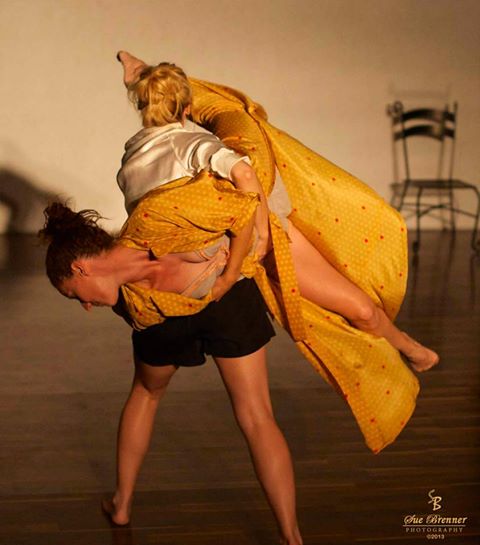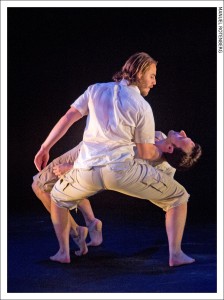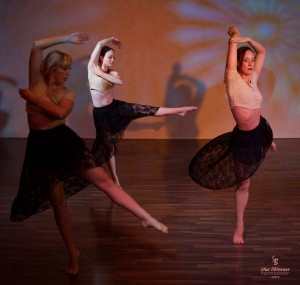Barton’s inspired Bodylogue heats up the Vine
As a performer with John Malashock and Jean Isaacs, Blythe Barton has captivated local audiences since 2008. The strong, willowy dancer has also emerged as a promising choreographer. She didn’t dance in Bodylogue, the show that opened the summer dance season at the Vine. Her troupe, Blythe Barton Dance, is composed of handsome dancers she’s performed with – and balanced on top of – and her strongest choreography favors narratives.
The love and relationship between Gertrude Stein and Alice B. Toklas was taboo, yet no secret, as seen in Barton’s duet “every one comes to be clear.” Danced by Anne Gehman and Cecily Holcombe, the dance offers a poignant glimpse into the lives of two women who shaped the avant garde in Paris, with groovy friends like Hemmingway, Matisse, and Picasso.
An intimate dance, “every one” was presented at the Fringe Festival earlier this month (as part of Infamous, dances about infamous couples). Performed in sleep wear and set to recordings of Stein’s repetitious poetry and woven with loving lyrics, the piece is sensual and heartfelt. The women eye each, embrace, and grip fabric with orgasmic energy. One can imagine two women in love in 1910 or so. Creaking noises suggest growing old together in rocking chairs.
Inside the small Vine Theatre this time, the dance seemed too rosy. In truth, as Jewish lesbians the couple had to hide from the Nazis. Stein suffered from stomach troubles and finally died of cancer. The work is inspired and beautifully danced, with exceptional focus. Geyman walked her fingers along the floor. The women were technically sharp in turns on diagonals. Changes in tempo were exhilarating. Still, to fully realize two unique personalities, the dance needed to give viewers more clues. Stein and Toklas do not appear glamorous or svelte in old photographs, and they don’t look alike. The dance didn’t give me a firm sense of who was who.
In “Duologue,” first presented at Hot Guys Dancing at Diversionary Cabaret in January, Barton creates a tantalizing body language for two men. Bradley R. Lundberg and Nicholas Strasberg approach each other as two beach guys staking out a stretch of sand, or early humanoids.
One slapped the side of his chest, then his heart. The other replied, and they slogged closer until they met in manly contact. Lifts in the realm of All-Star wrestling had amplified tension, and Lundberg and Strasberg made it look easy. How fun to watch overtly masculine mannerisms assembled by a lovely, feminine dance maker. Barton is able to harness the muscled energy because she’s danced with them, shared weight with them, and knows their abilities. The roughhousing conveyed the violent nature of men, but also the playful physicality among brothers and friends.
The program of six dances opened with “UniSound,” a trio set to a score of Gregorian chants. As its appellation suggests, it was a sonic experiment that that began in shadow. Putting dancers in the dark was too much a distraction. As ears enjoyed the sounds, eyes strained to see bodies and sliding feet forming arcs on the floor.
Viewers worried it was a technical glitch. When the lights came on, the dance took off. Gehman, Stephanie Harvey, and Cara Steen slapped their legs to create rhythm and changed direction with military precision. While Barton’s earliest training was in gymnastics and ballet, she channeled Graham’s modernism. Trance-like, the women created patterns in sweeping changes of direction to sink into deep second position; and they rose from the floor in contractions to become warriors in lace skirts and midriff tops.
In “Stranded,” a dance for four, Barton’s concerns are about being trapped, borders, and helping those in need. Dancers struggled to balance on blocks of wood, and rearranged them. The work suffered from predictable sequences, but picked up in the middle when blocks seemed to be a river that separated the group. There was a hint of allegory, troubles at the border, perhaps, but the work did not measure up to others on the program.
The solo “The Illusion of You” for Strasburg, shares the idea of being alone and trapped in a cage like an animal. As an ominous score by Josh Garrels rattled our brains, Strasburg flinched and gripped his wrists. He zigzagged on the diagonals and lifted imaginary objects.
Suddenly, a possible narrative became clear: this crazy guy was planning to move out of his apartment in the middle of the night, without paying the rent. And there was no air conditioning, which furthered the claustrophobic scene. A man pushed to his limit, he could only pace and coil his hands, as if unscrewing light bulbs. In the end, he discovered a single chair. Strasburg is a dancer of robust physicality, and this curious dance revealed a different, internally-driven side.
In “From Across the Room I felt Your Quake,” seven dancers were squeezed into the small box theatre. Overly ambitious, yes – it needed a larger venue. And while it felt like an oven in the little space (the Vine operators turn off the little AC during the dances), the work wasn’t fully cooked. The dance was drenched in melodramatic music, that might be considered techno pop, and the volume was turned up to 11. Still, it had great bones and pop, especially the beginning. Vibrating and sizzling, the dancers popped their heels off the floor in a domino progression until all raced in circles.
They flicked long hair and crossed the space like deer running through the woods with antlers on fire. There was no time to breathe. Even in the ordered chaos, I couldn’t take my eyes of Gehman and Harvey. Both terrific movers, the women seemed to enjoy every moment, leaping for no reason with calm eccentricity and grace.
The Vine Theater, operated by Mojalet Dance Collective, is located on the grounds of Bernardo Winery, 13330 Paseo Del Verano Norte, San Diego, CA 92128
Blythe Barton Dance can be found in the Wonderland Series in November, collaborating with a string trio, and in the Hot Guys Dancing event at Diversionary in January 2014.



